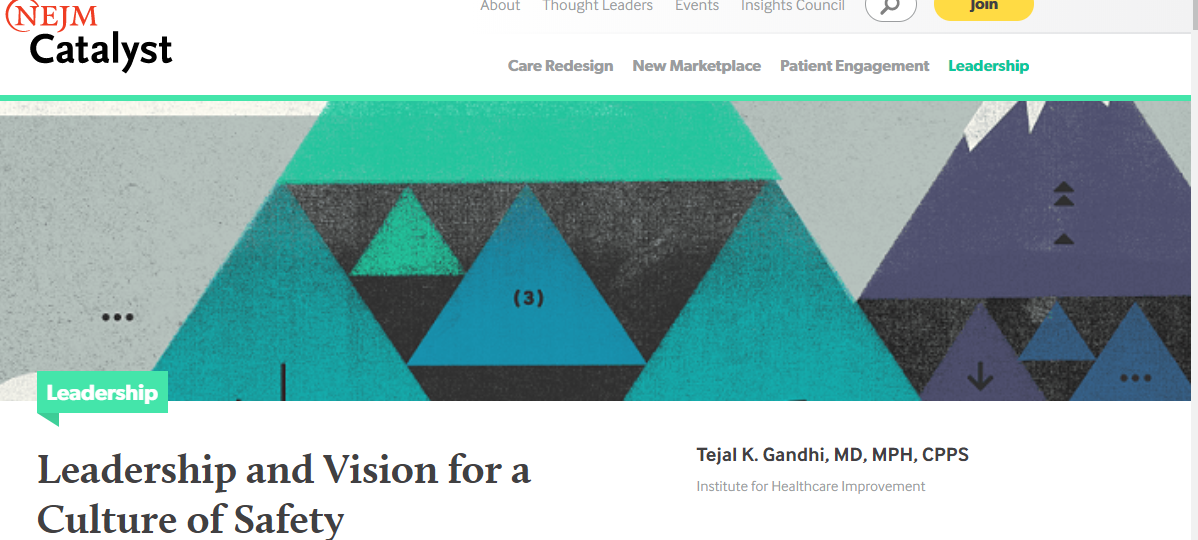
“Health care leaders consistently give voice to the importance of culture and safety. Asked to name the top leadership skills needed for success in the evolving health care environment, members of the NEJM Catalyst Insights Council — made up of health care executives, clinical leaders, and clinicians — put “building culture” in the top spot, with 47% citing it as a necessary skill in a 2016 report.
Leadership and culture also earned prominent mentions in a 2015 report from the National Patient Safety Foundation. The report’s top recommendation for advancing patient safety is for health care leaders to establish and maintain a culture of safety within their organizations.”
The foregoing excerpt from the February 8, 2018, New England Journal of Medicine Catalyst article by Tejal K. Gandhi, MD, MPH, CPPS of the Institute for Healthcare Improvement entitled “Leadership and Vision for a Culture of Safety” (http://bit.ly/2F4W3Ec) perpetuates the half-truth that leadership toward a culture of safety will make a significant impact on the mitigation of medical mistakes. Dr. Gandhi cites the Report’s six keys to a culture of safety as:
- establishing a compelling vision for safety;
- building trust, respect, and inclusion;
- educating and engaging board members in patient and workforce safety issues;
- emphasizing safety in the development and recruitment of clinical leaders and executives;
- adopting just culture principles to focus on systems flaws over individual blame when things go wrong; and,
- setting and modeling behaviors such as transparency, active communication, and civility as expectations for all.
A damning implication of “the keys” is that the healthcare provider community lacks sufficient trust and transparency, which deficiency is exacerbated by the inclination to blame rather than investigate and take constructive corrective action in the face of a medical mistake occurrence — the antithesis of the approach taken to airline accidents by the USA National Transportation Safety Board. In passing, we should note that this malevolent behavior is an apparent factor in the continuous reduction and only occasional occurrence of US airline accidents during the past quarter of a century, during the same period that medical mistakes now approach one-half million annually and thereby have become the third leading cause of patient deaths in the US after cancer and heart disease.
In fact, arguably medical mistakes are a derivative not as much from human factors as from human cognitive limitations which, exacerbated by the complex and often chaotic condition of a typical healthcare delivery venue, leads to the root cause of medical mistakes: cognitive overload. Therefore, real-time and readily available cognitive support is needed to mitigate medical mistakes, which support can be obtained cost-effectively only by the appropriate application of state-of-the-art information technology (IT).
The Cloud Healthcare Appliance Real-Time Solution as a Service (CHARTSaaS)© reference architecture (RA), which specifies features for the inclusion of process/case design, Boolean rules/decision design, Bayesian multi-dimensional similarity and predictive analytics, connectivity and interoperability with electronic health record (EHR) systems and other CHARTSaaS© Subscriber sources of data, and for development and deployment of mobile applications or “apps.” CHARTSaaS© is an IT integrated development environment that provides healthcare provider subject matter experts with easy-to-use tools for creating IT applications a.k.a. “apps” for real-time cognitive support for such problematic medical use cases as hand-off communications, failure to rescue, and differential diagnosis and treatment planning.
Please validate the foregoing CHARTSaaS©-related propositions to your own satisfaction by reading the white paper at http://bit.ly/2vmK1Rx, and viewing these presentations: https://www.youtube.com/edit?o=U&video_id=7NWcok1fi8Q, https://www.youtube.com/watch?v=j9VHOmsvSFQ. Healthcare providers will benefit significantly from appreciating and then applying a CHARTSaaS© RA-compliant IT solution. To do so will mitigate medical mistakes (currently the third leading cause of patient deaths. per Makaray and Daniel (http://bit.ly/1rtW6Sa); thereby minimizing patient adverse events and optimizing clinical case outcomes while maximizing the cost-effectiveness of care and treatment, and also accelerating the accrual and facilitating the application of medical knowledge. Please contact me, Pete Melrose, at jpmelrose@gmail.com or +1 (612) 201-2301 to discuss and decide re how you or your organization can participate — patient lives may depend on your decision. Thanks, and good wishes for another great day!